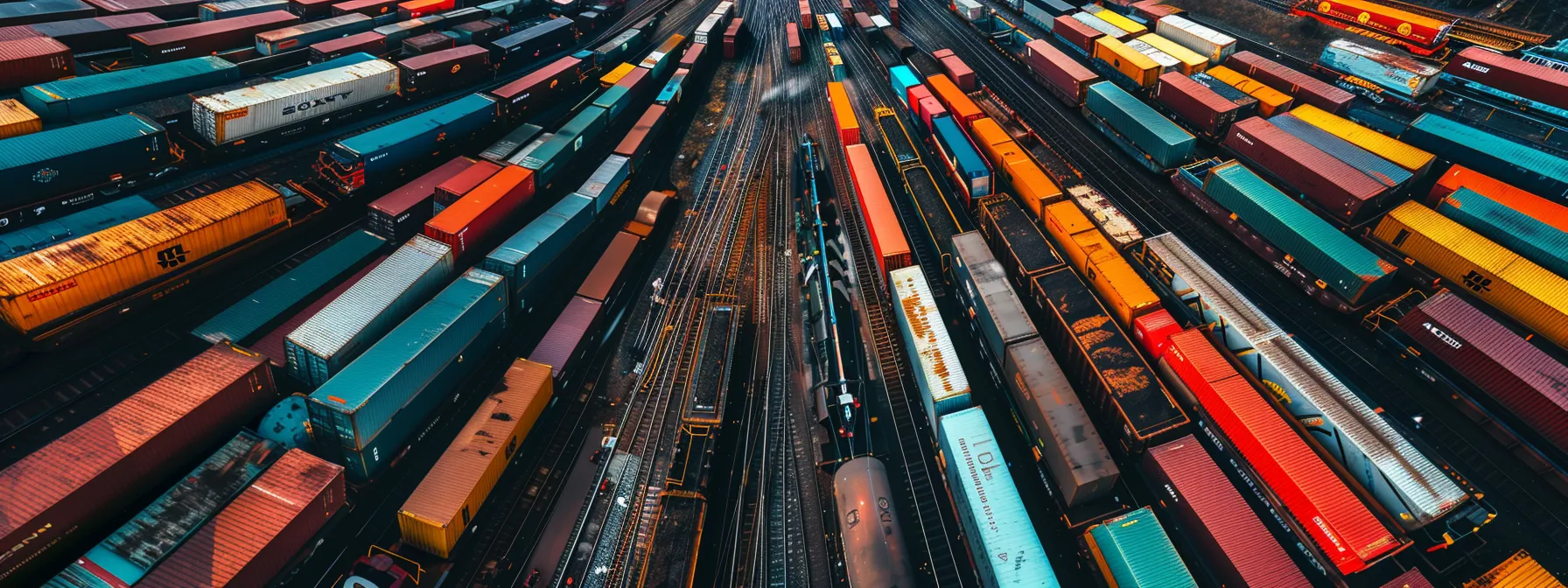Let’s explore the key benefits of rail transportation, such as cost efficiency, environmental impact, and capacity for large cargo freight containers. Gain insights into how rail freight can enhance their supply chain operations, particularly in retail and other industries. By addressing common challenges in transportation, we aims to provide practical solutions that can optimize logistics strategies and improve overall efficiency.
Key Takeaways
- Rail freight transportation is cost-effective for long-distance shipping of bulk goods
- It enhances supply chain efficiency and reduces logistics costs for various industries
- Technological advancements improve the reliability and safety of rail freight services
- Rail transport significantly lowers carbon emissions compared to road transport
- Choosing the right freight service provider is crucial for optimizing rail logistics
Introduction to Rail Freight Transportation

Rail transportation plays a crucial role in logistics, offering efficient freight shipping services that support global trade. Understanding the intricacies of tariffs, the function of freight brokers, and the importance of documentation like the bill of lading is essential. Additionally, refrigeration options enhance the transport of perishable goods, making rail a versatile choice for various industries.
Understanding Rail Freight Logistics
Understanding rail freight logistics involves recognizing the various dimensions that influence the movement of goods. A freight forwarder plays a vital role in coordinating shipments, ensuring compliance with customs regulations, and facilitating negotiation between shippers and carriers. Effective supply chain management is essential for optimizing rail transport, as it helps businesses streamline operations and reduce costs while maintaining timely deliveries.
The Role of Rail in Global Trade
Rail freight transportation plays a significant role in global trade by efficiently meeting the supply and demand for goods across vast distances. It serves as a reliable alternative to van and LTL freight shipping, particularly for bulk shipments that require consistent and timely transport. By integrating rail into their logistics strategies, businesses can optimize their shipping processes, reduce costs, and enhance their overall supply chain efficiency. Supply chain management plays a crucial role in this integration, ensuring that logistics operations are streamlined and effective.
- Rail freight supports efficient movement of goods.
- It meets the supply and demand for various industries.
- Rail is a reliable alternative to van and LTL shipping.
- Businesses can reduce costs and enhance supply chain efficiency.
Rail freight transportation offers a reliable way to move goods across vast distances. Understanding its key advantages reveals why many businesses choose this method for their shipping needs.
Key Advantages of Rail Freight Services

Rail freight services offer several key advantages that enhance logistics and international trade. Cost-effectiveness for long-distance shipping is a significant benefit, as rail transport often provides a favorable fee-to-distance ratio. Additionally, rail transport is known for its environmental benefits, reliability, and timeliness in delivery. The high capacity for bulk goods further solidifies rail’s position as a preferred choice in freight transport.
Cost-Effectiveness for Long-Distance Shipping
Rail freight transportation stands out as a cost-effective solution for long-distance shipping, particularly when evaluating performance indicators such as shipping rates and delivery times. For businesses involved in construction or those operating distribution centers, utilizing rail can significantly reduce transportation costs compared to traditional courier services, especially for bulk shipments. As demand for efficient logistics continues to rise, companies that integrate rail freight into their supply chain strategies can achieve substantial savings while ensuring timely delivery of goods.
Environmental Benefits of Rail Transport
Rail transport offers significant environmental benefits compared to traditional vehicle shipping methods, particularly for full truckload shipments. Studies indicate that rail can move a ton of freight over 400 miles on just one gallon of fuel, making it a more energy-efficient option. Additionally, the use of rail reduces the need for extensive packaging and labeling, as bulk shipments can be consolidated, further minimizing waste and environmental impact.
Reliability and Timeliness in Delivery
Rail freight transportation is recognized for its reliability and timeliness in delivery, making it a preferred mode of transport for various industries. With well-established schedules and dedicated routes, rail services ensure that cargo, including dangerous goods, reaches its destination on time, minimizing delays that can disrupt supply chains. Companies often enter into contracts with rail providers to secure consistent service, which is particularly beneficial for businesses that rely on timely deliveries to maintain operations and meet customer demands.
High Capacity for Bulk Goods
Rail freight transport is particularly advantageous for industries that require the movement of bulk goods, such as manufacturing and export. Freight carriers can accommodate large quantities of materials, making rail a preferred choice for transporting heavy and voluminous shipments. This capacity not only enhances efficiency but also reduces the overall cost per unit, allowing businesses to optimize their logistics and maintain competitive pricing in the market.
Rail freight offers clear benefits, but it is not the only option. Understanding the different types of freight transport services can help in making the best choice for your needs.
Comparing Types of Freight Transport Services

Rail freight transportation offers distinct advantages when compared to other freight transport services. This section will explore the efficiency of rail versus road freight, highlighting when to choose rail over air freight for time-sensitive shipments.
Rail Freight vs. Road Freight
When comparing rail freight to road freight, several factors come into play, particularly regarding price and the movement of bulk cargo. Rail freight often provides a more cost-effective solution for transporting large quantities of goods over long distances, which can significantly enhance the efficiency of a supply chain. While road freight offers flexibility and quicker delivery for smaller shipments, rail freight typically excels in quality of service for bulk shipments, ensuring that goods are transported reliably and at a lower cost per unit.
When to Choose Rail Over Air Freight
Choosing rail freight over air freight is often a strategic decision based on cost and shipment volume. For businesses transporting large quantities of goods, rail offers a more economical solution, especially when factoring in drayage costs associated with moving cargo to and from rail terminals. While air freight provides speed, rail freight excels in delivering bulk shipments reliably and at a lower overall cost, making it a preferred option for industries that prioritize efficiency and budget management.
Industries That Benefit From Rail Freight

Rail freight transportation significantly benefits various industries, particularly in the movement of agricultural commodities, mining and bulk raw materials, and automotive and manufacturing goods. Each sector leverages rail’s cost-effectiveness and capacity for bulk shipments, ensuring efficient delivery and reduced logistics costs. This section will explore how these industries utilize rail freight to enhance their supply chain operations.
Construction Material Transportation
The logistics of moving construction materials from suppliers to job sites is a crucial aspect that can significantly impact timelines, costs, and overall efficiency. Proper planning and coordination are essential to ensure that materials are delivered on time and in the right quantities to keep the project on track.
Effective construction material transportation involves careful consideration of factors such as the type and quantity of materials, the distance to be traveled, and the mode of transport to be used. Whether it’s transporting bulk materials like concrete and steel, or smaller items like tools and fittings, having a well-organized logistics plan is key to avoiding delays and minimizing disruptions. This includes choosing reliable transportation providers, optimizing delivery routes, and implementing measures to ensure the safe and secure transport of materials.
Investing time and resources into developing a comprehensive transportation strategy can yield significant benefits in terms of cost savings, project efficiency, and client satisfaction. By prioritizing communication, coordination, and attention to detail in the transportation process, construction professionals can streamline operations and maintain a competitive edge in an industry where timely delivery is paramount.
Drilled Shaft Support Materials Transportation
Drilled shafts are commonly used as foundation elements in infrastructure projects, and the materials needed for their construction must be delivered in a timely and cost-effective manner to ensure project timelines are met.
Transporting drilled shaft support materials involves careful planning and coordination to optimize logistics and minimize delays. This typically involves selecting the right transportation methods, such as trucks or barges, based on factors like project location, material type, and site accessibility. Coordinating with suppliers and logistics partners is essential to ensure that materials are delivered on schedule and in compliance with project specifications.
Efficient transportation of drilled shaft support materials not only helps to streamline construction processes but also contributes to project success by reducing downtime and increasing productivity. By leveraging my expertise in logistics and construction, I am able to provide optimal solutions for transporting these critical materials, ultimately helping to support the successful completion of infrastructure projects.
Mining and Bulk Raw Materials Transportation
Rail freight transportation is particularly advantageous for the mining industry, as it efficiently handles the movement of bulk raw materials such as coal, minerals, and metals. The high capacity of rail cars allows for the transportation of large quantities over long distances, reducing overall logistics costs and improving supply chain reliability. By utilizing rail, mining companies can ensure timely delivery of essential materials to processing facilities, addressing the industry’s need for consistent and efficient logistics:
- Rail freight efficiently transports bulk raw materials.
- It reduces logistics costs for mining companies.
- Rail ensures timely delivery to processing facilities.
- High capacity of rail cars accommodates large quantities.
Maximizing the Benefits of Rail Freight Transportation

Choosing the right freight service provider is essential for optimizing rail freight transportation. Effective planning and scheduling can enhance delivery timelines and reduce costs. Additionally, navigating regulations and compliance ensures that shipments meet legal requirements, minimizing delays. Each of these factors plays a critical role in maximizing the benefits of rail freight, providing businesses with practical insights to improve their logistics operations.
Choosing the Right Freight Service Provider
Choosing the right freight service provider is essential for businesses looking to maximize the benefits of rail freight transportation. A reliable provider not only ensures timely deliveries but also offers expertise in navigating complex logistics and compliance requirements. Companies should evaluate potential partners based on their track record, capacity to handle specific cargo types, and ability to provide tailored solutions that align with the unique needs of their supply chain.
Effective Planning and Scheduling
Effective planning and scheduling are critical components in maximizing the benefits of rail freight transportation. By accurately forecasting demand and aligning shipment schedules with production timelines, businesses can significantly enhance their logistics efficiency. For instance, companies that implement advanced planning tools can optimize their rail transport routes, ensuring timely deliveries while minimizing costs associated with delays and excess inventory.
Navigating Regulations and Compliance
Navigating regulations and compliance is a critical aspect of maximizing the benefits of rail freight transportation. Companies must stay informed about federal and state regulations that govern the movement of goods by rail, including safety standards and environmental guidelines. By partnering with experienced freight service providers, businesses can ensure that their shipments meet all legal requirements, thereby minimizing the risk of delays and penalties that can disrupt supply chain operations.
The landscape of rail freight is changing, driven by new technologies and shifting demands. As the industry looks ahead, the possibilities for growth and innovation are both exciting and essential.
The Future of Rail Freight Transportation

The future of rail freight transportation is shaped by several key factors, including technological innovations in rail systems, the expansion of rail networks, and rail freight’s role in sustainable logistics. Advancements in technology are enhancing efficiency and safety, while expanding networks improve accessibility for businesses. Additionally, rail freight is increasingly recognized for its environmental benefits, making it a vital component of sustainable logistics strategies.
Technological Innovations in Rail Systems
Technological innovations in rail systems are transforming the landscape of rail freight transportation, enhancing efficiency and safety. Advanced tracking systems and real-time data analytics allow companies to monitor shipments closely, reducing delays and improving overall service reliability. Additionally, automation in rail operations, such as the use of autonomous trains and predictive maintenance technologies, is streamlining processes and minimizing operational costs, making rail freight an increasingly attractive option for businesses seeking to optimize their logistics.
- Advanced tracking systems improve shipment monitoring.
- Real-time data analytics reduce delays and enhance reliability.
- Automation in rail operations streamlines processes.
- Predictive maintenance minimizes operational costs.
- Technological advancements make rail freight more attractive for businesses.
Expansion of Rail Networks
The expansion of rail networks is a critical factor in enhancing the efficiency of rail freight transportation. As new routes and connections are developed, businesses gain improved access to markets, facilitating faster and more reliable shipping options. This growth not only supports the movement of goods across regions but also contributes to reduced congestion on roadways, ultimately lowering transportation costs and enhancing supply chain performance for various industries.
Rail Freight’s Role in Sustainable Logistics
Rail freight transportation plays a pivotal role in sustainable logistics by significantly reducing carbon emissions compared to road transport. With the ability to move large volumes of goods efficiently, rail systems minimize the environmental impact associated with freight shipping. As businesses increasingly prioritize sustainability, integrating rail freight into their logistics strategies not only enhances operational efficiency but also aligns with global efforts to reduce the carbon footprint of supply chains.
Let’s get started
Rail freight transportation offers significant advantages that enhance logistics and support global trade. Its cost-effectiveness, environmental benefits, and reliability make it a preferred choice for industries requiring bulk shipments. By integrating rail into their supply chain strategies, businesses can optimize operations, reduce costs, and ensure timely deliveries. Understanding these benefits is essential for companies looking to improve their logistics efficiency and contribute to sustainable practices in the freight industry. Contact AMICUS to learn more.




